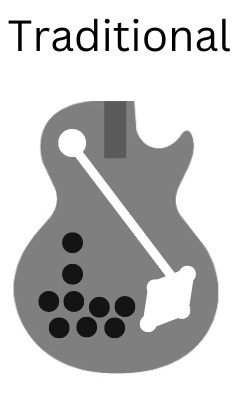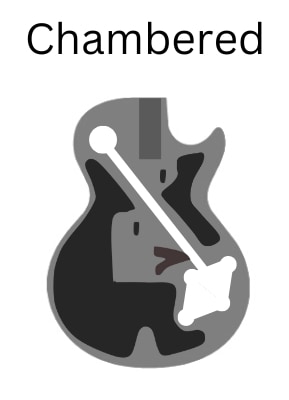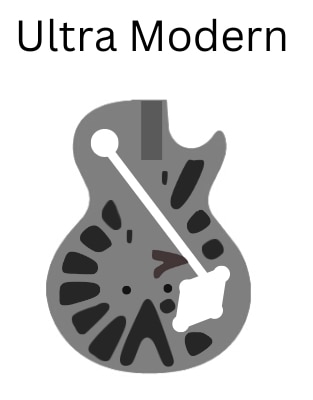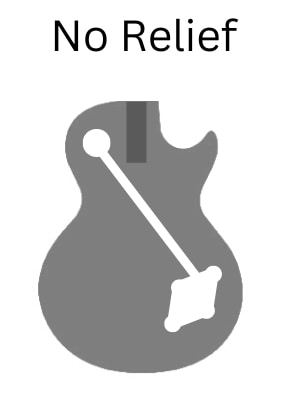Gibson Les Paul electric guitars are well-known for being very heavy, which does put some players off because it can make the instrument difficult to sit or stand with for longer periods of time. In order to counteract this, Gibson introduced “weight-relief” in 1982 to make the guitar lighter, but without changing the shape or overall thickness.
What is Weight Relief?
A weight-relieved Gibson Les Paul has chunks of wood carved out of the body in order to make the guitar lighter.
There are three main types of Gibson weight relief. The order from most to extreme weight-relief is: Chambered, Modern/ Ultra Modern, and finally Traditional/ 9-Hole.

Weight-relieving a guitar has the following effects:
- Increases susceptibility to feedback
- Decreases sustain
- Reduces the weight of the guitar
Feedback Susceptibility
Since a weigh-relieved guitar has sections of the body carved out of it, it is more prone to feedback because the sound waves bounce around inside the body of a semi-hollow guitar. The feedback is most noticeable when using high gain and high volume.
There are varying degrees of weight-relief (more on this later), with some being much more susceptible to feedback, and others which cause very little problems.
Effect on Tone and Sustain
Guitars with weigh-relief do not offer as much sustain as non-weight-relieved guitars because they have less mass. Again, the degree to which the sustain is affected really depends on the type of weight relief used.
Traditional 9-Hole and Ultra Modern/ Modern weight relief methods do not really affect the tone or sustain of the guitar, but Chambered weight relief does.
Chambered Les Pauls have less sustain and sound less “punchy” compared to non-weight relieved models.
Check out this comparison between a Gibson Les Paul without any weight-relief and one with Ultra Modern weight-relief.
Types of Weight Relief
There are three types of weight-relief which involve varying degrees of carving:
- Traditional (also known as 9-Hole)
- Modern/ Ultra Modern
- Chambered
Les Pauls which have chambered weigh-relief are the lightest, followed by Les Pauls with modern/ ultra modern weight-relief and finally those with traditional 9-hole weight relief.
Traditional/ 9-Hole Weight Relief
Traditional (also known as 9-hole or Swiss-cheese) weight relief was introduced in 1982 by Gibson and is still used on several models today. Gibson Les Paul guitars with Traditional 9-Hole weight relief typically weigh between 9.0-10.0 lbs.
The Traditional weight-relief method is not very dramatic and only involves carving 9 small holes out of the bottom bout of the body. The result is that the guitar is roughly 10% lighter than a non weigh-relieved Les Paul.

Since very little wood is carved out of the body, the guitar does not loose much sustain and does not produce much more feedback.
The following Gibson Les Paul guitars currently in production have traditional (9-hole) weight relief:
- Les Paul Classic
- Les Paul Custom
- Les Paul Axcess Standard
Chambered Weight Relief
Gibson introduced the “Chambered” weight relief system on Les Paul’s in Autumn 2006. Chambered weight-relief is the most dramatic method of weight-relief and is typically only used on Custom Shop models at present.
Chambering a Les Paul involves removing creating chambers either side of the route from the pickup selector to the control cavity.

Chambered weight-relieved Les Pauls generally weigh 7.5-8.5 lbs which is less than Les Pauls with modern/ ultra modern and traditional/ 9-hole weight relief.
The main drawback of the chambered weight-relief method is that it makes the guitar quite prone to feedback, meaning it very suitable to high-gain amp settings, hence it is a poor choice for hard rock and metal. The amount of sustain is also less compared to a non-weight relieved guitar.
Modern/ Ultra-Modern Weight Relief
Gibson introduced the “Modern” weight relief system in 2012. It involves removing more wood than the traditional/ 9-hole system, but less than the chambered weight relief system.
The “Ultra Modern” weight relief method has replaced the “Modern” weight relief method and is featured on many Les Paul’s currently in production. It has the same number of carvings but uses more rounded edges and slightly larger gaps to help balance the guitar more.

The advantage of Ultra Modern weight relief over Chambered weight relief, is that it reduces the amount of feedback, whilst still keeping the guitar quite light. Having Ultra Modern weight relief will result in a slight reduction in sustain compared to a solid guitar, but by a barely noticeable degree.
Gibson Les Paul guitars with Ultra Modern weight relief typically weigh between 8.5-9.5 lbs, making them lighter than Les Pauls with Traditional 9-Hole weight relief, but heavier than Les Pauls with chambered weight relief.
The following Gibson Les Paul guitars currently in production have Ultra Modern weight-relief:
- Les Paul Modern
- Les Paul Studio
- Les Paul Tribute
Solid Body (No Weight-Relief)
Gibson Les Paul guitars without any weight-relief typically weigh between 9.0-11.0 lbs.
The following Gibson Les Paul guitars currently in production do not have any method of weight-relief:
- Les Paul ’50s Standard
- Les Paul ’60s Standard
- Les Paul ’70s Deluxe
- Les Paul Special
- Les Paul Junior
- Les Paul Special Tribute

Comparing Weights
On average, a Gibson Les Paul weighs between 8 and 11 lbs (3.6-5.0 kg).
Gibson Les Paul guitars with no weight-relief typically weigh 9.5-11 lbs, whereas Les Pauls with Traditional 9-Hole weight relief generally weigh 9-10 lbs. Les Pauls with Ultra Modern weight relief usually weigh 9.0-9.5 lbs. Les Pauls with chambered weight relief are the lightest and typically weigh
Notice that there is some cross-over in between the average weight ranges of Les Pauls with different weight relief methods. This is because it also depends on the exact thickness and density of the mahogany used to construct the body, so there will always be some variation in weight from guitar to guitar.
| Gibson Weight Relief | Average Les Paul Weight | Example Models |
| None (Solid) | 9.5-11.0 lbs | Standard Special Junior |
| Traditional (9-Hole) | 9.0-10.0 lbs | Classic Custom Axcess Standard |
| Ultra Modern | 8.5-9.5 lbs | Modern Studio Tribute |
| Chambered | 7.5-8.5 lbs | Custom Shop Only |
Do Gibson Les Paul Standards Have Weight-Relief?
Gibson Les Paul ’50s and ’60s Standard guitars do not have any form of weight-relief at present, however previous versions did use weight-relief.
- 1952-1982: Gibson Les Paul Standards did not have any weight-relief
- 1982-2006: Gibson Les Paul Standards had Traditional 9-Hole weight relief
- Autumn 2006-Spring 2012: Gibson Les Paul Standards had Chambered weight relief
- Spring 2012-2017: Gibson Les Paul Standards had Modern Weight relief
- 2017-2018: Gibson Les Paul Standards had Ultra Modern Weight relief
- 2019-Present: Gibson Les Paul Standards do not have any weight-relief
Frequently Asked Questions
Is a Gibson Les Paul Traditional weight relieved?
The Gibson Les Paul Traditional does not have any weight-relief.
What year did Gibson start weight relieving?
Gibson first introduced weight relief on the Les Paul in 1982 using the traditional 9-hole method.
What is the difference between 9-hole traditional and modern/ ultra modern weight relief?
Modern/ ultra-modern weight-relief involves removing more wood compared to traditional 9-hole weight relief. Modern weight-relieved guitars are roughly 0.5-1.0 lbs lighter but produce slightly more feedback and have slightly less sustain compared to guitars with traditional weight relief.
